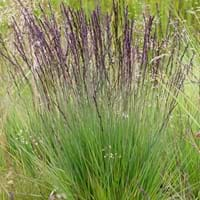Life Span
Perennial
Perennial
Origin
Southeastern United States, North-Central United States, Central United States, South-Central United States, Southwestern United States, Texas, Canada, Mexico
Asia, Europe, North Africa
Types
Not Available
purple moor-grass 'Moorhexe', variegated purple moor-grass
Habitat
Dry areas, Prairies, Rocky areas, rocky outcrops
Boggy areas, Dry and Young forest Heaths, Lowland
USDA Hardiness Zone
3-10
4-8
Sunset Zone
A1, A2, A3, H1, H2, 1a, 1b, 2a, 2b, 3a, 3b, 4, 5, 6, 7, 8, 9, 10, 11, 12, 13, 14, 15, 16, 17, 18, 19, 20, 21, 22, 23, 24
1a, 1b, 2a, 2b, 3a, 3b, 4, 5, 6, 7, 8, 9, 14, 15, 16, 17
Habit
Upright/Erect
Clump-Forming
Flower Color
Yellow, Purple, Burgundy, Light Green, Brown
Dark Purple
Flower Color Modifier
Bicolor
Bicolor
Fruit Color
Brown
Non Fruiting Plant
Leaf Color in Spring
Light Green, Gray Green
Green, Dark Green
Leaf Color in Summer
Light Green, Gray Green
Light Green
Leaf Color in Fall
Light Green, Gray Green
Green, Yellow green, Gold
Leaf Color in Winter
Light Green
Tan
Leaf Shape
Subulate
Needle like
Plant Season
Summer
Spring, Summer, Fall, Winter
Sunlight
Full Sun
Full Sun, Partial Sun
Type of Soil
Loam, Sand
Clay, Loam, Sand
The pH of Soil
Neutral
Acidic, Neutral
Soil Drainage
Well drained
Average
Bloom Time
Late Spring, Early Summer, Summer, Late Summer
Late Spring, Summer, Late Summer, Early Fall, Fall
Tolerances
Drought
Not Available
Where to Plant?
Ground
Ground, Pot
How to Plant?
Seedlings
Divison, Transplanting, Vegetative Reproduction
Plant Maintenance
Medium
Low
Watering Requirements
Average Water Needs, Water in morning to avoid prompting diseases
Requires regular watering, Water more frequently during periods of extreme drought
In Summer
Lots of watering
Lots of watering
In Spring
Moderate
Moderate
In Winter
Average Water
Average Water
Soil pH
Neutral
Acidic, Neutral
Soil Type
Loam, Sand
Clay, Loam, Sand
Soil Drainage Capacity
Well drained
Average
Sun Exposure
Full Sun
Full Sun, Partial Sun
Pruning
Cut or pinch the stems, Pinch Tips, Remove damaged leaves, Remove dead branches, Remove dead flowers, Remove dead leaves, Remove dead or diseased plant parts, Remove deadheads
Prune in winter, Remove damaged leaves, Remove dead branches, Remove dead leaves
Fertilizers
All-Purpose Liquid Fertilizer, Apply N-P-K
No need to fertilize every year
Pests and Diseases
Pests and diseases free, Red blotch
Pests and diseases free
Plant Tolerance
Drought, Dry Conditions, Dry soil, Full Sun
Not Available
Flower Petal Number
Single
Single
Foliage Texture
Fine
Fine
Foliage Sheen
Matte
Matte
Attracts
Birds, Butterflies
Not Available
Allergy
Rhinitis
Not Available
Aesthetic Uses
Borders
Showy Purposes, Water gardening
Beauty Benefits
Not Available
Not Available
Environmental Uses
Air purification
No fertilizer, pesticides, or herbicides needed
Medicinal Uses
Analgesic
No Medicinal Use
Part of Plant Used
Flowers
Whole plant
Other Uses
Can be made into a herbal tea, Used in making tea
Used as Ornamental plant
Used As Indoor Plant
No
No
Used As Outdoor Plant
Yes
Yes
Garden Design
Container, Cutflower, Mixed Border, Wildflower
Container, Foundation, Mixed Border
Botanical Name
RATIBIDA columnifera
Molinia caerulea
Common Name
Mexican Hat
purple moor-grass
In Hindi
Mexican Hat
बैंगनी दलदल घास
In German
Mexican Hat
Pfeifengras
In French
Mexican Hat
pourpre lande-grass
In Spanish
mexican Hat
púrpura amarra-hierba
In Greek
Mexican Hat
μωβ Moor-γρασίδι
In Portuguese
Mexican Hat
purple moor-grass
In Polish
Mexican Hat
fioletowy Moor-trawa
In Latin
Mexicanus Hat
Maurus herba-purpura,
Phylum
Tracheophyta
Magnoliophyta
Class
Magnoliopsida
Liliopsida
Order
Asterales
Cyperales
Family
Asteraceae
Poaceae
Clade
Angiosperms, Asterids, Eudicots
Angiosperms, Commelinids, Monocots
Tribe
Not Available
Not Available
Subfamily
Not Available
Not Available
Number of Species
Not Available
Not Available
Season and Care of Mexican Hat and Molinia Caerulea
Season and care of Mexican Hat and Molinia Caerulea is important to know. While considering everything about Mexican Hat and Molinia Caerulea Care, growing season is an essential factor. Mexican Hat season is Summer and Molinia Caerulea season is Summer. The type of soil for Mexican Hat is Loam, Sand and for Molinia Caerulea is Clay, Loam, Sand while the PH of soil for Mexican Hat is Neutral and for Molinia Caerulea is Acidic, Neutral.
Mexican Hat and Molinia Caerulea Physical Information
Mexican Hat and Molinia Caerulea physical information is very important for comparison. Mexican Hat height is 30.00 cm and width 30.50 cm whereas Molinia Caerulea height is 120.00 cm and width 30.00 cm. The color specification of Mexican Hat and Molinia Caerulea are as follows:
Mexican Hat flower color: Yellow, Purple, Burgundy, Light Green and Brown
Mexican Hat leaf color: Light Green and Gray Green
Molinia Caerulea flower color: Dark Purple
- Molinia Caerulea leaf color: Green and Dark Green
Care of Mexican Hat and Molinia Caerulea
Care of Mexican Hat and Molinia Caerulea include pruning, fertilizers, watering etc. Mexican Hat pruning is done Cut or pinch the stems, Pinch Tips, Remove damaged leaves, Remove dead branches, Remove dead flowers, Remove dead leaves, Remove dead or diseased plant parts and Remove deadheads and Molinia Caerulea pruning is done Prune in winter, Remove damaged leaves, Remove dead branches and Remove dead leaves. In summer Mexican Hat needs Lots of watering and in winter, it needs Average Water. Whereas, in summer Molinia Caerulea needs Lots of watering and in winter, it needs Average Water.





